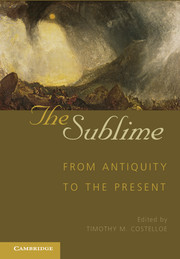Book contents
- Frontmatter
- Contents
- List of Illustrations
- Contributors
- Acknowledgments
- The Sublime
- Part One Philosophical History of the Sublime
- Part Two Disciplinary and other Perspectives
- 10 The First American Sublime
- 11 The Environmental Sublime
- 12 Religion and the Sublime
- 13 The British Romantic Sublime
- 14 The Sublime and the Fine Arts
- 15 Architecture and the Sublime
- Bibliography
- Index
- References
10 - The First American Sublime
Published online by Cambridge University Press: 05 January 2015
- Frontmatter
- Contents
- List of Illustrations
- Contributors
- Acknowledgments
- The Sublime
- Part One Philosophical History of the Sublime
- Part Two Disciplinary and other Perspectives
- 10 The First American Sublime
- 11 The Environmental Sublime
- 12 Religion and the Sublime
- 13 The British Romantic Sublime
- 14 The Sublime and the Fine Arts
- 15 Architecture and the Sublime
- Bibliography
- Index
- References
Summary
INTRODUCTION
Intellectuals on the far side of the world looked eagerly to English andcontinental savants to help them make sense of their place, even as theyinhabited a landscape that few across the Atlantic could imagine. The provincialinhabitants of the British colonies in North America confronted nature in itsmost primal setting, and perhaps the great cultural work of the Anglophonicmigration was to render terra incognita into vernacular terms.For two centuries this was largely an empirical undertaking, but the AmericanRevolution and the subsequent invention of the American state compelledAmericans to expand their imagined geography to encompass both a physicalenvironment – North America – and an emergent community conceivedin revolution – the United States. Place and ideology commanded a uniformexplanation, and the Enlightenment authorized a totalizing narrative thatintimately conjoined what Samuel Stanhope Smith, president of the College of NewJersey, loosely referred to as “climate” with the character ofsociety, and, indeed, with the individual as well. The varieties of complexionsamong the American Indians, Smith observes, are “nothing more than theknown effects of climate, of food, of culture, or of other natural causes,operating on animal bodies … here they are seen in lower stature, andthere of taller and more noble port.” His emphasis on the somatic ischaracteristic of a society obsessed with racial difference, and this firmbelief that the peculiar “climate” of North America literallystamps its impression on the “animal bodies” of its inhabitants isa powerful cultural trope. The kindred conviction that nature thus animatedmight in turn shape thought informed a multitude of intellectual, social, andpolitical dialogues during the era of revolution and the formation of the earlyAmerican republic.
Information
- Type
- Chapter
- Information
- The SublimeFrom Antiquity to the Present, pp. 147 - 170Publisher: Cambridge University PressPrint publication year: 2012
References
Accessibility standard: Unknown
Why this information is here
This section outlines the accessibility features of this content - including support for screen readers, full keyboard navigation and high-contrast display options. This may not be relevant for you.Accessibility Information
- 10
- Cited by
